
Press the black link for page, back to return here.

Press the black link for page, back to return here.
|
|
| Condensed
History:
Of the Germans arriving in Russia, only a few were farmers. On one side of the Volga river (Bergseite), the terrain was rolling and covered with forests. On the other side (Wiesenseite), the land was a grass covered plain. Their first wheat crop was eaten by rodents and grasshoppers. Crop failures tended to follow year after year, until they learned how to cope with the land, the climate, and also its marauders. Tribal marauders struck often. The Volga region was populated by nomadic tribes, living on the Ural steppes, called Kirghiz, Kalmuka and Bashkirs who preyed on victims. Also the rebel Pugachev, a Don Cossack, who passed himself off as Czar Peter IV, plundered and committed atrocities on the colonists. During the same period the kirghiz reinvaded their homelands. By 1775, about 4,000 of the original 26,000 germans had lost their lives or had been sold into slavery. By 1790's the colonies began to prosper and became the agricultural pacesetters of Russia. Now they were efficient farmers and cattle breeders. Gradually, mills for grain and weaving were built, supplying the Crown and other cities along the Volga with goods and service. Healthy and prosperous, the population grew to 60,746 persons by 1816.. Then unease began, succeeding Tzar's began to take away the original rights and added further debt loads to the Volga community. |
| Russian Exploitation:
Empress Catherine II had forgiven the debt that resulted from the destruction of villages, farms and ransom, but in 1842, Nicholas I and officials rejected this decision and demanded total payment from the colonists. The new debt load prevented proper economic development resulting in keeping these people poor. The colonists were systematically exploited, almost to the point of serfdom, by officials of the government, called Kontors, throughout most of their history. A lot of this constant interference and eventual rejection of the premises in Catherine's Manifesto finally led to seeking of migration out of Russia by the Volga Germans in the 1870's. Reinhardt Yauk:
Even though we cant detirmine what Yauk relatives remained in Russia
after 1912, there is no doubt they existed in Holstein, consequently for
their memory, further tribulations up to 1941.
|
|
The famine of 1921 began with a drought that caused massive crop failures, including total crop failure on about 20 percent of Soviet farmland. The Bolsheviks simply ignored the famine until it was largely too late. Unwilling to admit natural disasters could strike in the worker's paradise, Lenin took actions to protect himself politically but did nothing to prevent the starvation. Even when finally requesting aid, and the USA and others responded to relieve the Russian famine, the Soviets sold millions of tons of cereals for hard currency rather than feed its starving people. Exact casualty figures don't exist, but a Soviet estimate put the death toll at 5 million with 166,000 dying from the Volga region. Famine of 1932-33:
In 1932, the Soviets increased the grain procurement quota by 44%. They were aware that this extraordinarly high quota would result in a grain shortage, therefore resulting in the inability of the people to feed themselves. Grain was removed from the people and stored in larger cities. Kulaks:
1941 Deportation:
(Trudarmee
- Slave Labor Camps)
|
|
|